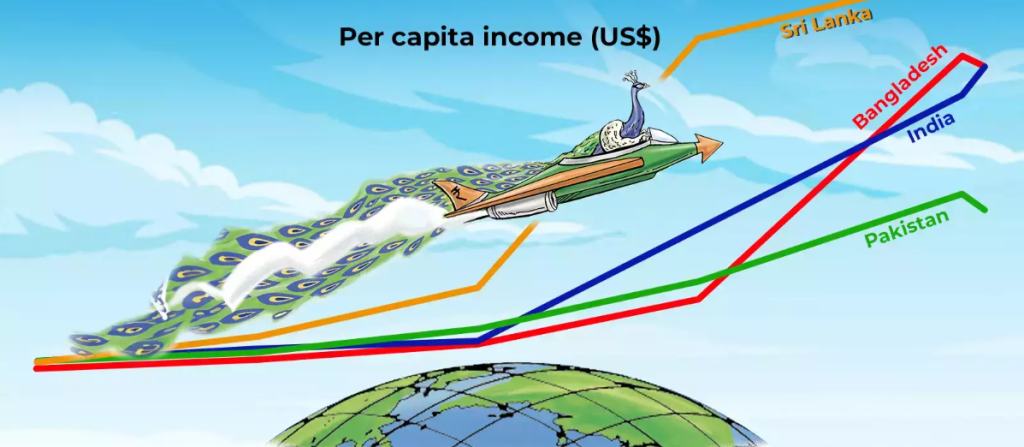It is the largest economy in South Asia, but it’s not the best-off. Important lessons, not just for India but also its neighbours, based on per capita incomes from 1980 to 2023
The Government of India boasts that India is a coming superpower, a ‘Vishwaguru’ and ‘Voice of the Global South’. Readers may be surprised that India is only third in per capita income (measure of the amount of money earned per person in a nation) in South Asia.
Right now, the “world is on fire”, says economist Larry Summers. India’s neighbours — Pakistan, Sri Lanka and Bangladesh — have all gone to the International Monerary Fund (IMF) for help.
But India is rock solid, with plaudits pouring in. However, before getting euphoric, look at the chart below giving the changes in per capita income in nominal (or actual) dollars for the four countries.
All four countries were very poor in 1980. Pakistan was numero uno ($294), followed by Sri Lanka ($269), India ($267) and Bangladesh ($216).
By 1990, Sri Lanka had taken the lead, a remarkable performance given its two civil wars, with the Tamil Tigers in the north and the Marxist Janatha Vimukthi Peramuna (JVP) in the south. But after a long period of socialism till 1978, the country had switched to economic liberalisation, which helped greatly.
In 1990, Sri Lanka’s per capita income was $467. India ($369) had edged ahead of Pakistan ($346), but was about to crash to $304 in its 1991 balance of payment crisis. Bangladesh still brought up the rear with $294.9.
The collapse of the Soviet Union in 1991 ended socialist tendencies everywhere. All the Indian subcontinent’s countries embarked on economic liberalisation. But making the transition took time. Just when things were looking up, especially for India, the subcontinent was hit by the Asian financial crisis (1997-99), followed by the worst drought for a century in 2000.
Sri Lanka, the most liberalised and the least drought-hit (it benefits from both the South-West and NorthEast monsoons), galloped ahead to $870. Pakistan was a distant second ($531), followed by India ($442) and Bangladesh ($413).
Then came the best decade across the world — 2000-2010 — when China became a global locomotive pulling the rest of the world at a record pace. The subcontinent soared. The Great Recession of 2008 ended the party. But the subcontinent proved resilient, and suffered less than the West.
By 2010, Sri Lanka’s per capita income had soared to $2,837. It vanquished the Tamil Tigers in 2009, sparking a tourism boom. India more than tripled its per capita income to $1,351, rising to second position, but well behind Sri Lanka.
Pakistan decelerated to third position ($911). Bangladesh was still last ($777), but its garment industry was growing fast, promising a bright future.
2020 was distorted by the Covid pandemic and, hence, is left out in our chart.
In 2022, Sri Lanka still led the pack, but had slowed a lot. It enjoyed extraordinarily fast growth till 2017 when its per capita income peaked at $4,388. But then it collapsed to $3,354 by 2022 because of a crisis caused by high foreign debts and fiscal deficits, compounded by a crash in tourism during the pandemic.
Meanwhile, Bangladesh emerged as a new miracle economy, more than tripling its per capita income in 2010-2022 to touch $2,688. It overtook even India ($2,388). Pakistan, which led in 1980, was now a distant fourth ($1,596).
Bangladesh’s remarkable performance stemmed largely from its magnificent garment industry. It failed to produce similar results in other industries, and now has a burgeoning trade deficit, obliging it to seek an IMF loan.
IMF has published forecasts for 2023. These show Bangladesh ($2,620) and India ($2,610) almost level. Pakistan has sunk even lower to $1,470. There are no estimates for Sri Lanka.
What are the lessons?
■ Sri Lanka’s early lead in education since 1900 and economic reforms in 1978 have kept it on top, despite constant economic crises. It has gone to IMF a whopping 17 times. Nevertheless, its good education and open economy enable it to power ahead despite setbacks.
■ Bangladesh had done well by overtaking India in social indicators and garment exports. But its dependence on a single industry renders it fragile. Its lead over India may not last long. Its currency is seriously overvalued, causing a large trade deficit, also giving the illusion of a high dollar per capita income.
■ Pakistan has ruined its prospects through poor politics and economics. It has failed to industrialise enough or tax its elite, and is over-dependent on foreign aid, once from the US and now China. It has gone for IMF rescues 23 times in 75 years — almost once every three years!
■ India has done better in improving per capita income since 1980 than Pakistan, but not Sri Lanka or Bangladesh. It is the largest economy in South Asia, but not the best-off. Its main advantage is its tax-gross domestic product (GDP) ratio of 18%, more than double that of its neighbours. Hence, India can afford more freebies than the others without creating a crisis.
Yet, it is sobering that India’s people remain poorer than others in South Asia, even as the country claims to be a rising superpower.
This article was originally published by The Times of India on November 22, 2023.


